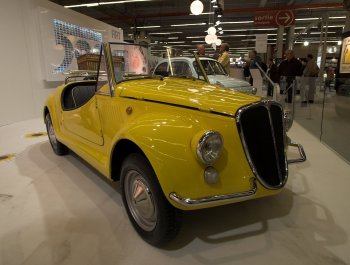|
The Fiat Club of
France, with official support, chose the occasion of this
year's edition of Rétromobile to celebrate the 50th
anniversary of its little 500, and build up to the arrival
of the exciting new model this summer. To a backdrop
emblazoned with the "500" lettering and featuring graphics
depicting Italian style of the period, the line-up of 500
models included a pair of Abarth-tuned versions, the
Giardiniera (estate) and the very rare Vignal-bodied Gamine.
With the Fiat 500, Dante Giacosa made it possible for every
Italian family to own an automobile Dante Giacosa, a
talented polytechnic engineer and head of the Fiat
engineering division, gave shape to the project of creating
an automobile that every Italian family could afford to own.
Such a car would have to be strong, economic and simple: the
Nuova 500 rolled out of the Fiat factories in 1957. The
little Fiat is a fully-fledged automobile; its two-cylinder,
air-cooled 479 cc engine enabled it to reach 90 km/h. With a
large roof opening, the new model appealed immediately to
thousands of Italians. It was soon to be found on all the
roads throughout Europe. Production of the little Fiat
lasted 18 years, producing a total of 3,678,000 cars. Today,
it is not unusual to see one threading its way through the
streets of our major cities; the years have not tarnished
the success of the Fiat 500 and it remains the world’s
smallest 4-seater car.
Carlo Abarth's
eponymous tuning company is indelibly linked with the tiny
Fiats, and this deep thread was demonstrated at
Rétromobile this year with two 500 Abarth versions,
including a pristine 695SS, being on show. Based on the Fiat
500D, the 595 was the result of Carlo Abarth's efforts with
the little cars; it was introduced in 1963. The engine was
enlarged to 593.7cc by increasing the bore and numerous
other modifications were made to the inlet and exhaust
manifolds, camshaft, sparkplugs, cylinder head, pistons and
valve springs.
|
 |
|
Wrapping up the Fiat Club of France's display at
Rétromobile was an eye-catching, bright yellow
finished Vignale-bodied Gamine; a model which was
built between 1967 and 1974 in very low volumes. |
|
 |
|
|
 |
|
Carlo Abarth's eponymous tuning company is indelibly
linked with the tiny Fiats, and this deep thread was
demonstrated at Rétromobile this year with two 500
Abarth versions being on show. |
|
 |
|
|
The end result produced 27bhp. The car was otherwise little
changed, a revcounter and oil pressure gauge being options.
The following year saw the arrival of the still more potent
(32bhp thanks mainly to a new carburettor) 595SS and the new
695 and 695SS, the latter model being celebrated by
appearing on show at Rétromobile. The latter cars had
a 689,5cc engine with 30 and 38bhp respectively. Again
designed for competition, the 695SS was available with
numerous options such as disc brakes (at the front). The 695
was discontinued in 1966, whilst the 695SS also became
available with widened wheelarches. Production of these cars
(the 595, 595SS and 695SS) continued until 1971.
Wrapping up the
Fiat Club of France's display at Rétromobile was an
eye-catching, bright yellow finished Vignale-bodied Gamine;
a model which was built between 1967 and 1974 in very low
volumes. The 500 Gamine was based on the Fiat 500F. A spider
coachwork by Vignale, it was released late in 1967 and
incorporated the complete 500 floorpan (1840mm wheelbase,
with additional strengthening) and the same two cylinder
499.5cc engine with 22bhp. A slightly reduced weight (488kg)
combined with the exposed seating all serves to give the
impression of greater speeds than the saloon. A canvas
soft-top was available as an option from 1968, and a plastic
hard top was also manufactured for some time. Seating was
strictly for two, and the luggage space was virtually
non-existent, the space under the bonnet being occupied by
the spare wheel and fuel tank. A total of two to three
hundred examples were built.
|
|
|
|